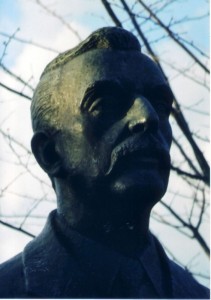 This is part of a series on Lafcadio Hearn, a Shinto sympathiser 100 years ahead of his time. Though he was not as proficient in language terms as his great Shinto contemporaries, such as B.H. Chamberlain and W.G. Aston, he had a mastery of words which was striking enough to win worldwide attention.
This is part of a series on Lafcadio Hearn, a Shinto sympathiser 100 years ahead of his time. Though he was not as proficient in language terms as his great Shinto contemporaries, such as B.H. Chamberlain and W.G. Aston, he had a mastery of words which was striking enough to win worldwide attention.
Thanks to his Greek mother, and no doubt also to the power of his imagination, Hearn had a fascination with the pagan myths of ancient Greece. These seized him in a way that Christian tales did not. When he came to Japan, he felt that he had discovered a land in which the spirit of ancient Greece was still alive and well.
It shouldn’t be forgotten that there was an upsurge in interest in ancient Greece in Victorian times. It began at Oxford, where dons such as Benjamin Jowett and Walter Pater promoted Greek in preference to Latin. One of the students to be influenced by this was Oscar Wilde, who based much of his aestheticism on the Greek cult of beauty. Like his contemporary Hearn, Wilde was versed in Celtic myth and saw the two cultures as sharing a similar aesthetic sensibility.
It was his pagan inclinations that attracted Hearn to the native religion of Japan. In ‘A Pilgrimage to Enoshima’ in Glimpses of Unfamiliar Japan (1894), he writes movingly of the joy of discovering a living version of a faith he only knew as long vanished in Europe. It’s a feeling I myself have shared.
To have studied and loved an ancient faith only through the the labors of palaeographers and archaeologists, and as a something remote from one’s own existence, and then suddenly in after years to find the same faith a part of one’s human environment – to feel that its mythology, though senescent, is alive all around you – is almost to realize the dream of the Romantics, to have the sensation of returning through twenty centuries into the life of a happier world. For these quaint Gods of Roads and Gods of Earth [Koshin] are really living still, though so worn and messed and feebly worshipped… and I know myself a pagan still, loving these simple old gods, these gods of a people’s childhood.
*********************
For Part I comparing Hearn with his more scholarly friend, Basil Hall Chamberlain, translator of Kojiki, please see here. Part 2 deals with his life and house at Matsue, Part 3 a reflection upon mirrors.

Entrance to the main shrine on Enoshima

The Dragon Cave on Enoshima, of which Hearn writes so evocatively

Leave a Reply